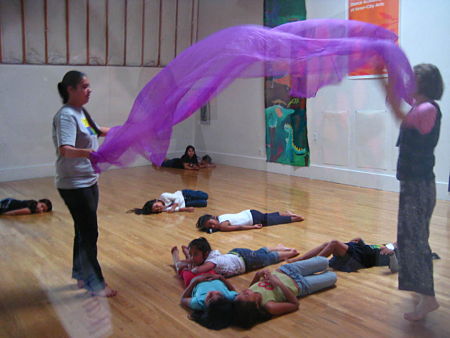Skid Row Arts Program Fosters Creativity In The Classroom
Brenda Miranda closed her eyes and rested her head against the drama studio wall as she enveloped herself in a memory. Mary Ann Tate sat Indian-style on a carpet square nearby recalling a memory of rice paddies. Jan Kirsch reminded them that it needed to be a memory they were comfortable "staying in for a while." She then told the two students along with eleven others to come up with words describing the memory. They sat on the floor brainstorming descriptors for the environment, actions and their feelings. The room was quiet and it would be a few more minutes before Kirsch revealed that these words would help them create a haiku.
Miranda and Tate aren't children though; they are teachers. And they came to Inner-City Arts to develop their art instruction skills.
"The first day we had to draw," Miranda said. "I'm not an artist. I don't know how to draw. But when I had the lesson I felt comfortable because everyone was doing it and there was some great pictures there."
Inner-City Arts' most is hard to miss among the desolation of Skid Row. The acre-sized campus, which has enough green space to qualify as an urban forest, houses drama, dance, ceramics, visual arts and various other studios. The non-profit usually serves underprivileged children, but for five Saturdays teachers are the ones being served.
The mission is to engage students in developing their creative process. With art instruction being trimmed from schools across the country, these teachers are taking initiative to develop their teaching skills. Creativity in the Classroom allows teachers to learn more about the discipline especially if they never received formal art training.
"They're exploring their own creativity and there's a lot of growth and a lot of self-discovery that happens," Kirsch said.

Barendo Middle School students learn about movement in the dance studio.
(photo by Nardine Saad)
Kirsch, who is the director of professional development, said the purpose of the program is to support teachers in coming back to the creativity, intuition, love of learning and love for children that initially brought them to teaching. The non-profit works to empower educators as students and "bring the arts, and specifically creativity, whether it's in the arts or across the curriculum, into the classroom."
On the last day of the workshop, teachers learned how to write and perform their haikus with musical complements, put together a character sequence based on masks they made in a previous session and act out a short play they created. Before that, they drew and danced. Each time the activity was fleshed out in a way for them to map out their creative process from beginning to end and the program aims to foster the students' emotional development through that creative process.
"The reason I come is because of the kids," Miranda said. "Most of the art school, it's hands on...so we have to teach them how to express their feelings."
Inner-City Arts, which was founded in 1989 in response to art education being cut from public schools, serves 90 schools with children at or below the poverty level. Its mission is to give literacy to different parts of academic life. They provide most services free of charge and the programs are funded through grants, partnerships and donations. The professional development programs are additional ways to serve them. But money is still an issue in most schools, and the arts are still getting cut first.
Los Angeles Unified School District (LAUSD) faces a $600 million deficit and the prospect of laying off 5,000 teachers. The district is likely to cut most instructional leadership branches, including the art branch, by June 30. But with assistance from the district, the partnerships are helping them bridge the gaps in arts education.
Some of the Creativity in the Classroom students pay $150 out of their own pocket for the series. But those affiliated with Los Angeles Unified School District earn salary points because of the district's partnership with Inner-City Arts.
"Partnerships are more than just budget filling," said Dale Petrulis, director of civic engagement for Los Angeles Unified School District. "Partnerships give us the opportunity to harness and attract human resources and services...we get skills and talent and access to other programs that we otherwise wouldn't have."
The school district is attempting to salvage art education, but how do they maintain art education without the proper knowledge, training, facilities and equipment?
"Obviously, when there are budget constraints, we still want our youngsters to be exposed to what people on the outside world are doing for a living and their passions," Petrulis said. "We need the connections to the real world for the youngsters to connect to the real world."
While multi-subject teachers receive some of instruction in the arts, most times the teacher's comfort level with the subject is variable.
"My wish would be to see teachers come together around strategies for teaching thinking and teaching problem solving," said Connie Covert, programming and planning coordinator for the district's arts education branch. "They would start to recognize that there are strategies and pedagogies that arts teachers use that generalist class teachers can use in other content areas."
Still, Inner-City Arts is looking for ways to step in when needed.
"With the changes in LAUSD," Kirsch said, "we're focusing more on the geographic area again and focusing on schools."
Inner-City Arts serves about 450 students a day and about 8,000 a year. But the Los Angeles Unified School District has nearly 700,000 students and cut $43 million from art-related funding for the 2008-2009 school year. So leaning on a non-profit isn't the answer. And despite the 87 community art partners and the district's opening of an art-centered high school in September, most students will remain underserved.
"Our current education system has come out of this whole factory model, preparing workers for factories," Kirsch said. "That mode of education is no longer needed. So we're really about creating a kind of education that provides opportunities for the whole child to be educated and to be ready as a whole person in our society."
Many educators argue that because the arts are inter-disciplinary they can be integrated with pre-existing curricula. And through their partnership with Los Angeles Unified School District, district teachers can bring their classes to the Inner-City Arts campus and do the hands-on activities alongside their students.
"The students see them as learners," Kirsch said.
Tate, who teaches at Ninth Street Elementary School, attended the workshop to receive salary points. She took her first graders to the campus on May 11 for art instruction, but she has already taken some of the art lessons she learned during the workshop to her classroom.
"It helps balance their learning. It's just not reading it's just not doing math," Tate said. "It's something they also enjoy. If a kid does not enjoy learning you just can't force it down his or her throat."
Her school has a large English as a Second Language enrollment, but after a few art lessons that required her students to reflect on their process and feelings, she noticed major improvement.
"Now that I integrated art I see that they're able to express their ideas," Tate said. "They're able to translate their ideas from that art form into writing and what I noticed, from the whole of my class, is that writing comes easily now after the fact that they've done some form of art."
Because of her school's location in Skid Row, she said there are many transient students. She believes the arts are a means to get them to stay in school because they would be doing something they enjoy.
But should parents expect to find another Picasso or Gaugin among these children? Possibly, but that isn't the point, Kirsch said.
"Every human being has a creative seed and if nurtured it can manifest in magical ways...It's not about teaching the art form it's about teaching the children."
Roberto Hernandez, a fourth grade teacher at Esperanza Elementary School calls himself a "frequent customer" of Inner-City Arts because they provide resources he can't provide in the classroom. Hernandez said that art education helped his students find their niche.
"Intrinsically, I know they are artistically inclined," he said. "But until I bring them here, that's when I really find out this student that was shy does really well in visual arts. Or this student that I've always known talks a lot comes alive in drama."
Kirsch said the program's strength has always been honoring unique individuals.
Studies have shown that art helps students perform better in other subjects. And in Creativity in the Classroom, teachers learned that happens because the creative journey is just as important as the destination.
"I didn't even think about the relationship between subjects that didn't even relate to each other," said Leslie Fraser, a teacher at the Kidspace Children's Museum in Pasadena. "You can suddenly go from ceramics, to writing to theater, so you combined all three and there's a lot of literacy that can be involved with visual arts and a lot of visual art that can be integrated into performance as well."
Fraser attended the workshop to build her technique in educating children about the arts, especially at a young age. She rubbed her hands together, stomped her feet and tapped her fingers with her classmates to simulate the sound of rain and didn't feel uncomfortable when she might have before.
"If you can think outside the box, which I feel like is in its purest form in art," Fraser said, "you can apply that to science, you can apply that to your ability to dictate whether it be a business, whether it a group of people or a greater community."
Even though Inner-City Arts has had to restructure because of funding problems and an increased need for services in the community, they are still trying to keep staff on and look for more efficient ways to serve.
"We are deeply committed to serving children and to serving teachers and we always will," Kirsch said.
"How that happens may change form and structure sometimes but the depth of the commitment to the service will never change no matter how the funding environment or the educational environment changes."
She continues to see changes as additional opportunities to be creative.
"We just ride the pendulum as it swings." And she imagines that the pendulum "has a little light on the bottom of it that lights new places."



